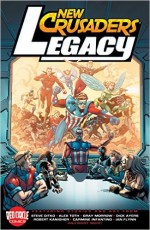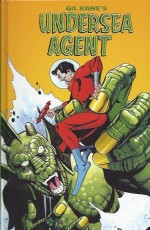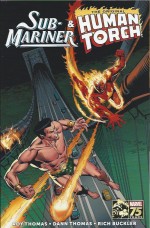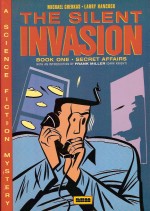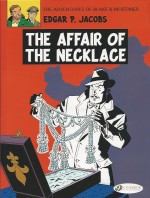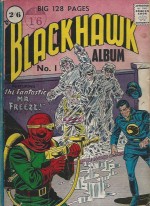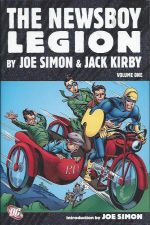
By Joe Simon & Jack Kirby with Arturo Cazeneuve, Gil Kane & others (DC Comics)
ISBN: 978-1-4012-2593-3
Just as the Golden Age of comics was beginning, two young men with big dreams met up and began a decades-long association that was always intensely creative, immensely productive and spectacularly in tune with popular tastes. As kids they had both sold newspapers on street-corners to help their families survive the Great Depression …
Joe Simon was a sharp-minded, talented young man with five years experience in “real†publishing; working from the bottom up to become art director on a succession of small paper such as the Rochester Journal American, Syracuse Herald and Syracuse Journal American.
He then moved to New York City and a life of freelancing as an art/photo retoucher and illustrator. Recommended by his boss, Simon joined Lloyd Jacquet’s pioneering Funnies Inc.; a production “shop†generating strips and characters for a number of publishing houses all eager to cash in on the success of Action Comics and its stellar attraction Superman.
Within days Simon created The Fiery Mask for Martin Goodman of Timely Comics (now Marvel) and became acquainted with young Jacob Kurtzberg, a cartoonist and animator just hitting his stride with the Blue Beetle for the Fox Feature Syndicate.
Together Simon and Kurtzberg (who went through a legion of pen-names before settling on Jack Kirby) enjoyed a stunning creative empathy and synergy which galvanized an already electric neo-industry with a vast catalogue of features and even sub-genres.
They produced the influential monthly Blue Bolt, rushed out Captain Marvel Adventures (#1) for Fawcett and, after Martin Goodman appointed Simon editor at Timely, created a host of iconic characters such as Red Raven, the first Marvel Boy, Hurricane, The Vision, The Young Allies and of course the million-selling mega-hit Captain America.
Famed for his larger than life characters and colossal cosmic imaginings, “King†Kirby was an astute, spiritual hard-working family man who lived though poverty, gangsterism and the Depression. He loved his work, hated chicanery of every sort and saw a big future for the comics industry…
When Goodman failed to make good on his financial obligations, Simon & Kirby jumped ship to National/DC, who welcomed them with open arms and a fat chequebook. Bursting with ideas the staid company were not comfortable with, the pair were initially an uneasy fit, and were given two strips that were in the doldrums until they found their creative feet: Sandman and Manhunter.
They turned both around veritably overnight before, once established and left to their own devices, creating the “Kid Gang†genre (technically “recreating†as the idea was one of the duo’s last innovations for Timely in 1941’s Young Allies) with a unique juvenile Foreign Legion dubbed The Boy Commandos.
The little warriors began by sharing the spotlight with Batman in flagship publication Detective Comics, but before long they had won their own solo title which promptly became one of the company’s top three sellers.
Boy Commandos was such a success – frequently cited as the biggest-selling US comicbook in the world at that time – that the editors, knowing the Draft was lurking, green-lighted the completion of a wealth of extra material to lay away for when their star creators were called up.
S&K assembled a creative team which generated so much material in a phenomenally short time that Publisher Jack Liebowitz suggested they retool some of it into adventures of a second kid gang and thus was born The Newsboy Legion (and their super-heroic mentor The Guardian)…
Pitched halfway between a surly bunch of comedy grotesques and charming naive ragamuffins as seen in the Our Gang/Little Rascals film shorts (1922-1944), the Newsboy Legion comprised four ferociously independent orphans living together on the streets, peddling papers to survive. There was earnest, good-looking Tommy Tompkins, garrulous genius Big Words, diminutive, hyper-active chatterbox Gabby and feisty, pugnacious Scrapper, whose Brooklyn-based patois and gutsy belligerence usually stole the show. They were headed for a bad end until somebody extraordinary entered their lives…
Their exploits generally offered a bombastic blend of crime thriller and comedy caper, leavened with dynamic superhero action and usually seen from a kid’s point of view. The series debuted in Star-Spangled Comics #7, forcing the Star-Spangled Kid and Stripesy off the covers. The youngsters remained lead feature until the end of 1946, when without fanfare or warning issue #65 found them gone: ousted and replaced by Robin, the Boy Wonder.
His own youth-oriented solo series subsequently ran all the way to SSC #130 in 1952, by which time superhero romps had largely been supplanted throughout the industry by general genre tales.
This first superb hardback collection reprints the first 26 episodes, spanning Star-Spangled Comics #7-32 (April 1942-May 1944), includes all the stunning covers by Kirby, inker Arturo Cazeneuve, Fred Ray and teenager Gil Kane) and opens with a lyrical and revelatory reminiscence from Joe Simon himself. His invaluable Introduction ‘Birth of the Legion’ leads straight into a potent tale of skulduggery pitted against idealism to create optimism in the darkest of urban outposts as ‘The Story of the Newsboy Legion’ introduces rookie cop Jim Harper walking a beat in the inner city hellscape dubbed Suicide Slum.
When he is jumped by a gang of thugs and severely beaten, Harper takes an unlikely step: raiding a costume store and putting together an outfit to obscure his identity (complete with mask, shield and crash-helmet) before hunting down his attackers and giving them the thrashing they so richly deserve…
Happily, his illegal actions accidentally result in the capture of an infamous kidnap ring, and the mysterious figure is dubbed the Guardian of Society by the newspapers selling like hotcakes on street corners. Harper has no intention of repeating his foray into vigilantism but when he catches Tommy, Big Words, Gabby and Scrapper shoplifting, his life changes forever.
The tough little monkeys are headed for reform school until the cop makes an earnest plea for clemency on their behalf and the judge appoints him their guardian. They are far from grateful and send him packing but when their next get-rich-scheme gets them involved with armed bandits the kids realise the mettle of the man they’re saddled with…
Now hopelessly implicated in the crimes of murderous mobster Frankie the Fence – and witnesses to his crimes – the boys are about to die when a human thunderbolt in a mask and helmet comes to their rescue.
In actual fact it’s unclear who saves whom, but the in the end the Newsboy Legion are finally set on a righteous path, but with their suspicions are aroused. Frustratingly, no matter how hard they try, the boys can’t prove that their two Guardians are the same guy…
And so the scene was set: the kids constantly looking for broadly legal ways to make a living whilst Harper hovered over them as a guide and his alter ego worked tirelessly behind the scene to keep them alive and extricate from the trouble that always found them on the streets and alleys of the most-crime-infested slum in America…
The very next month Tommy stumbled onto the hideout of fugitive killer Black Leo Lucas and his abduction to ‘Last Mile Alley’ led the fighting mad Guardian to a confrontation with the latest Big Boss who thought he was untouchable, after which ‘The Rookie Takes the Rap’ saw Harper framed by devious gambler Sure Thing Kelly and only cleared by the actions of his now-devoted foster-kids…
To be frank, the relationship between Jim and the boys was never properly defined. Although he was responsible for keeping them out of trouble, they never lived with him and generally provided for themselves whilst – presumably – still sleeping on the streets…
Having now made a few headlines of their own, the boys were offered the chance to be ‘Kings for a Day’ in Star-Spangled Comics #10: running various municipal departments in a grand civic publicity stunt. Sadly, the event was hijacked by mobster The Mark, whose plans to plunder the entire city would have succeeded had he not underestimated those pesky kids temporarily in charge of the emergency services…
Many stories worked powerfully against a pervasive backdrop of crushing poverty and social injustice. Issue #11 saw the boys arrested by a heartbroken Jim for burglary and sent to the State Reformatory. What he didn’t know was that the boys had learned of corruption at the ‘Paradise Prison’ and were determined to expose unctuous, sanctimonious Warden Goodley for the sadistic grafter he truly was…
With little kids starving in their hovels and resorting to petty theft, the boys next decided to make a documentary with borrowed film equipment. Naturally their hunt for perfect locations dropped them right in the laps of a gang of bank bandits resulting in a ‘Prevue of Peril’ requiring another last-minute save by the blockbusting blue-&-gold mystery man with the pot on his head…
With the clue in their name, the Newsboy Legion still made the majority of their living vending newspapers. Whenever the tabloids weren’t selling, things got tough and in SSC #13 falling sales spurred the lads to create their own local periodical. With Harper’s assistance the premier issue of the Slum Sentinel proved a huge success but ‘The Scoop of Suicide Slums!’ made the area too hot for the crooks in their warrens. However, in trying to crush the little newsmakers, the city’s biggest racketeer only exposed himself to the Legion’s scrutiny and their Guardian’s furious fists…
Philanthropist Wilbur Whilling was a man with a plan. Using the Legion as his unwitting shills, he convinced the slum dwellers to donate everything they had to build a new modern apartment project to house them all. ‘The Meanest Man on Earth!’ never expected the kids to uncover his fraudulent alliance with the lawyers and planners to repossess the spiffy new complex, and certainly wasn’t ready for the personal retribution doled out by Scrapper and the man in the mask.
Arturo Cazeneuve came aboard as prime inker with ‘Playmates of Peril!’ in #15 as Patrolman Harper’s frequent absences led to his being partnered with an ever-present supervising sergeant. That didn’t stop his trouble-magnet wards wandering into another criminal caper and being taken hostage, necessitating a storm of frantic improvisation to save the kids, his job and his secret identity…
After Tommy saved a little boy from being run over he was eagerly adopted by rich banker Willis Thornton. He didn’t want to go but his pals forced him to take his shot at escaping the ghetto. All too soon ‘The Playboy of Suicide Slum!’ was framed for a robbery at the Thornton mansion and needed his true brothers to clear his name, after which ‘The Newsboy Legion versus the Rafferty Mob’ found the boys in a turf-war with a rival gang of street toughs led by the toughest girl they have ever encountered. Hostilities ceased as soon as a gang of gunsels started using the distraction as a way of trapping the Guardian…
‘The Education of Iron-Fist Gookin’ saw the slum’s most brutal thug taking elocution lessons from Big Words, and picking up a few morals – plus a pardon and new start – along the way, after which ‘The Fuehrer of Suicide Slum’ focused on Scrapper and took the odd narrative liberty to depict the boys battling Nazis after a sneak attack and invasion of New York City…
Steve Brodie inked the return to comicbook reality in Star-Spangled Comics #20 ‘The Newsboys and the Champ!’ with the kids helping hillbilly boxer Zeke Potts negotiate the lethally crooked fight biz in the big city before ‘The House Where Time Stood Still’ (Cazeneuve inks) found the kids – selling war bonds – invading a derelict house and discovering a pair of be-whiskered hermits who had shunned the world for decades.
The belligerent old Presby brothers soon changed their isolationist attitudes after Nazi spies moved into their home so it’s a good thing the Legion didn’t take that first “no†for an answer…
Gabby wrecks an automobile and incurs a dubious but huge debt in ‘Brains for Sale!’ (Cazeneuve), and his proposed payment solution only leads the entire team into deadly danger from an underworld surgeon after which ‘Art for Scrapper’s Sake’ (inked by John Daly) sees the bellicose boy discover his extremely profitable creative side. Typically, he’s far from happy to find that he’s just the patsy for a high-end art fraud…
Cazeneuve returns as regular inker with ‘Death Strikes a Bargain’ in SSC #24, as a crackdown on crime in Suicide Slum leads to the kids being parachuted into a luxurious new life in a bold social experiment. Sadly, however, the reformer in charge has a murderous ulterior motive for his seeming benevolence…
A vacation growing vegetables on a farm in ‘Victuals for Victory’ only lands the kids in more trouble as their nearest neighbours turn out to be bucolic bandits hiding out after a big city crime spree whilst ‘Louie the Lug Goes Literary’ sees the masked Guardian bust a major felon and inadvertently spark a massive hunt for the racketeer’s favourite tome and the incredible secrets it holds
Star-Spangled Comics #27 finds the lads volunteering as fire-fighters just in time to encounter an arsonist-insurance inspector eager to ‘Turn on the Heat’ whilst #28’s ‘Poor Man’s Rich Man’ sees kindly night watchman Pop O’Leary inheriting a fortune. Immediately lavishing largesse on all the others unfortunates in Suicide Slum, Pop only starts to worry as his unpaid bills mount and the lines of credit dry up, and the Newsboys discover the generous geezer is the victim of a cruel plot by saboteurs. They furiously take appropriate action, with the two-fisted Guardian coming along for the ride…
Always looking for a sold investment, the kids then hop on the publishing bandwagon in ‘Cabbages and Comics’; hoping to make a million peddling their own strip magazine. Their big mistake is incorporating local hoodlums’ likenesses and overheard snippets of gossip in the final mix, but naturally their masked protector is on hand to prevent them perishing from the rightful indignation – and guns – of the plunderers they inadvertently exposed and plagiarized…
In SSC #30 a reformed crook is framed and ‘The Lady of Linden Lane’ suddenly abandons her miserly ways and starts acting very strangely, leading the lads to uncover a devilish fraud after which neophyte Gil Kane illustrates ‘Questions, Please?’ with brilliant Big Words and even his less cerebral comrades becoming radio quiz sensations on the very night the dread Purple Mask gang raid the studio.
This stunning assemblage of astounding articles then concludes with Star-Spangled Comics #32 as the boys act as ‘The Good Samaritans!’ (Kane & Harry Tschida), unknowingly sheltering a gang of impoverished and starving thieves who have millions in hot cash they can’t spend… yet…
After years of neglect the glorious wealth of Jack Kirby material available these days is a true testament to his influence and legacy, and this magnificent and compelling collection of his collaborations with fellow pioneer Joe Simon is another gigantic box of delights that perfectly illustrates the depth, scope and sheer thundering joy of the early days of comics.
© 1942, 1943, 1944, 2010 DC Comics. All rights reserved.



